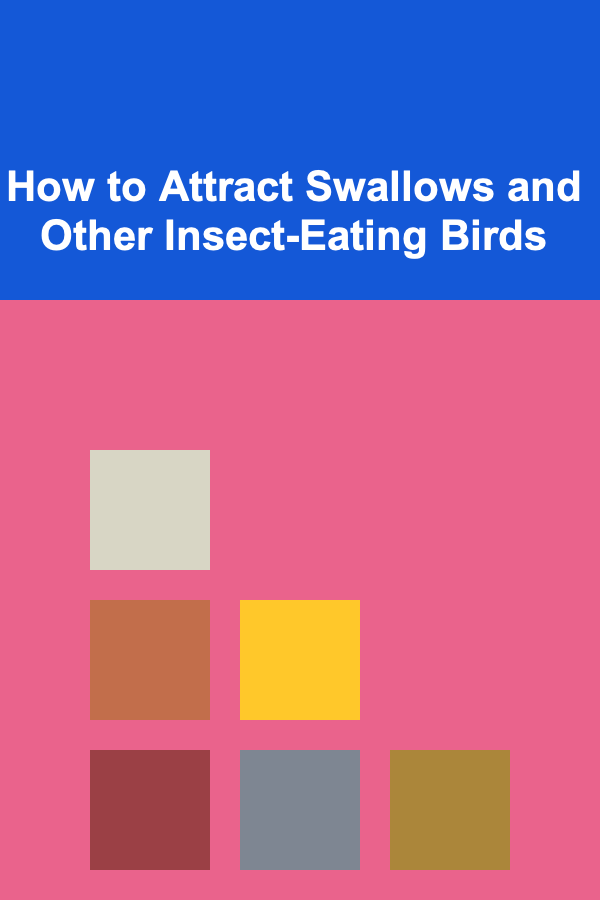
How to Attract Swallows and Other Insect-Eating Birds
ebook include PDF & Audio bundle (Micro Guide)
$12.99$5.99
Limited Time Offer! Order within the next:

Birdwatching can be an incredibly rewarding hobby, especially when you find ways to attract birds to your yard. Among the most beloved and useful birds to attract are swallows and other insect-eating birds. These birds can help control insect populations, keep your garden healthy, and bring a certain charm to your outdoor spaces. But how can you draw these birds into your environment?
In this comprehensive guide, we'll explore the various strategies and steps you can take to attract swallows and other insect-eating birds to your home. From providing the right food and shelter to creating an inviting environment, we will cover everything you need to know to support these valuable birds.
Understanding the Role of Swallows and Insect-Eating Birds
Before diving into the how-to's of attracting swallows and other insect-eating birds, it is important to understand their roles in the ecosystem.
1.1. The Importance of Insect-Eating Birds
Insect-eating birds play a crucial role in controlling insect populations. Many of these birds have an appetite for a variety of insects, including mosquitoes, flies, beetles, and even harmful pests like aphids. This natural form of pest control can reduce the need for harmful chemical pesticides, which are often detrimental to the environment.
Swallows, for example, are particularly skilled at catching flying insects while in flight, making them highly efficient in reducing flying insect populations. Other insect-eating birds like flycatchers, wrens, and swifts contribute similarly.
By attracting these birds to your yard, you not only provide them with food but also benefit from a more balanced ecosystem. It's a win-win situation for both birds and humans.
Creating an Insect-Friendly Environment
The first step in attracting insect-eating birds is to make your yard an attractive place for the insects they feed on. If your yard is devoid of insects, the birds won't have a reliable food source, and they'll be less likely to stick around.
2.1. Encourage a Healthy Insect Population
A healthy insect population can be encouraged by taking several steps:
- Plant Native Plants: Native plants support a variety of insects, from pollinators like bees to pest species that birds prey upon. Opt for plants that attract insects such as wildflowers, shrubs, and flowering trees.
- Minimize Pesticides: While pesticides can reduce insect populations, they also harm birds and other beneficial wildlife. Avoid using chemical pesticides, especially those that target insects birds rely on.
- Water Sources: Water sources attract insects and provide birds with the hydration they need. A pond, birdbath, or even a shallow dish of water can help draw insects and birds to your yard.
- Provide Leaf Litter and Mulch: Many insects live in the soil, beneath leaves, and in mulch. By allowing leaves and mulch to accumulate in some areas of your garden, you create a habitat for insects. The birds will then benefit from this abundance of food.
2.2. Providing Nesting Sites
In addition to attracting insects, providing appropriate nesting sites is essential for attracting swallows and other insect-eating birds. Different species of birds have specific nesting preferences, so understanding their needs will increase your chances of success.
- For Swallows: Swallows are cavity-nesting birds, meaning they prefer to build their nests in sheltered locations such as under eaves, in barns, or on buildings with overhanging structures. If you have a barn, shed, or similar structure, you can encourage them by installing swallow nesting boxes.
- Birdhouses: Many other insect-eating birds, such as purple martins, wrens, and flycatchers, also benefit from birdhouses. Ensure that these houses are designed specifically for the species you are hoping to attract. For example, wrens prefer small, dark nesting sites, while purple martins prefer larger, open birdhouses.
- Platform Nesting: Some birds, like the barn swallow, will readily use open platforms for nesting. If you don't have structures for nesting boxes, you can create simple platforms that allow birds to build their nests in a safe location.
Offering the Right Food
While insects are the primary food source for swallows and other insect-eating birds, providing supplementary food can help encourage birds to visit your yard. By offering the right type of food, you create an even more welcoming environment.
3.1. Insect Larvae
Although adult insects are a primary food source, many birds will also feed on insect larvae, which are often found in the soil or on plants. One way to provide this food source is by introducing composting areas where larvae thrive. You can also avoid using chemical fertilizers, which can harm insect larvae, allowing for a healthy population to grow.
3.2. Birdseed
While insect-eating birds primarily consume insects, certain species will also enjoy supplemental birdseed. For example, offering mealworms or dried insects can attract a variety of insect-eating birds to your yard. Offering seeds, such as sunflower seeds, can also attract other bird species that may not directly eat insects but will contribute to a vibrant bird population in your area.
3.3. Attracting Flying Insects
Swallows are particularly known for catching flying insects. To attract them, you can create an environment that encourages flying insects like flies, moths, and mosquitoes. This can be done by using flowering plants, particularly those that bloom in the evening when moths are active. Some plants, such as lavender, thyme, and certain fruit trees, also attract insects at different times of the day.
Creating the Right Habitat
Creating the right habitat involves more than just planting flowers or putting up a birdhouse. It's about creating an environment where swallows and other insect-eating birds feel safe, comfortable, and encouraged to stay.
4.1. Open Space for Flying
Swallows are aerial acrobats and need open space to hunt for insects. They are attracted to areas with plenty of flying room. If you have a large, open garden or field, it is more likely to attract these birds. You can enhance this environment by keeping certain areas of your yard free from dense vegetation or obstacles, allowing birds to swoop and dive freely.
4.2. Perches and Roosting Spots
Swallows and other birds will appreciate having a place to rest while they scout for food. Install perches around your garden, such as wooden poles or branches. Birds will use these spots to rest, preen, and observe the area for potential food sources. Bird-friendly trees and shrubs also provide perfect roosting spots.
4.3. Shelter from the Elements
Providing shelter is another important aspect of creating an inviting environment. Swallows need a safe place to rest and protect themselves from harsh weather conditions. Planting dense shrubs or having a structure with overhangs can offer shelter from rain or strong winds. Be sure to make these shelters easy for the birds to access, avoiding clutter that might obstruct their movement.
Seasonal Considerations
Different species of swallows and insect-eating birds may migrate during different seasons. Understanding the seasonal patterns of these birds is important when planning to attract them to your yard.
5.1. Spring and Summer
The best time to attract insect-eating birds like swallows is during the warmer months. Spring and summer are the times when insects are abundant, and birds are nesting. During these seasons, provide plenty of food, water, and nesting sites. Swallows are particularly active during these months, making it the ideal time to create an environment conducive to their needs.
5.2. Fall and Winter
While many insect-eating birds migrate during the colder months, you can still attract some species that remain year-round, such as chickadees and woodpeckers. These birds will often seek out food sources during the winter months. By providing year-round bird feeders, water sources, and shelter, you can help support these wintering birds, and occasionally, you might see late-season swallows or migrating birds in your yard.
Patience and Observation
Attracting swallows and other insect-eating birds requires patience and careful observation. You may not see immediate results, but over time, if you provide the right conditions, the birds will start to take notice. Keep an eye on your yard, noting which plants and strategies work best in attracting birds, and make adjustments as needed.
Birdwatching is not only about attracting birds but also about fostering a deeper understanding of wildlife and nature. As you observe the behaviors of swallows and other birds, you'll gain a better appreciation for the delicate balance of ecosystems and the vital role that insects and birds play in maintaining it.
Conclusion
Attracting swallows and other insect-eating birds is a rewarding endeavor that contributes to a healthier, more balanced environment. By providing food, shelter, and the right habitat, you can create a sanctuary for these valuable birds. Whether it's through planting native plants, offering insect larvae, or installing birdhouses, every effort you make will help build a welcoming space for these wonderful creatures.
With time, you'll not only help control pest populations in your area but also witness the beauty of these birds in flight, doing their part to keep nature in harmony. Enjoy the process of attracting and observing swallows and other insect-eating birds, and know that your efforts are supporting both the birds and the environment around you.

How to Plan a Birthday Celebration: Things That Fit Any Budget
Read More
How to Set Up a Home Gallery for Your Antiques
Read More
How to Use Slow Cookers and Instant Pots for Meal Prep
Read More
How to Use Virtual Assistants for SEO and Product Listing Optimization in Dropshipping
Read More
How To Find Meaning in Suffering
Read More
How To Appreciate the Raw Energy of Garage Rock
Read MoreOther Products

How to Plan a Birthday Celebration: Things That Fit Any Budget
Read More
How to Set Up a Home Gallery for Your Antiques
Read More
How to Use Slow Cookers and Instant Pots for Meal Prep
Read More
How to Use Virtual Assistants for SEO and Product Listing Optimization in Dropshipping
Read More
How To Find Meaning in Suffering
Read More